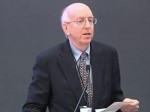This is something near and dear to my heart. I’ve always been a second class citizen in this country. Rarely have I enjoyed the protection of the law, instead I’ve been subject to the rule of man. I’ve never been able to remain employed after the “real men” figured out I like other men a little too much for “their” comfort. Some people complain that I don’t play by the rules or that I don’t think the rules apply to me. There is a reason: My very existence has been defacto illegal for most of my life. Until now.
Eight Times a Federal Judge Eviscerated Wisconsin, Indiana’s Marriage Bans
In a scathing decision issued just days after oral argument, the Seventh Circuit Court of Appeals roundly denounced bans on same-sex marriage in Indiana and Wisconsin.
By Matt Baume
September 05 2014 12:30 PM ET
Following a contentious oral argument on August 26th, it took the Seventh Circuit Court of Appeals less than 10 days to unanimously rule that the bans on same-sex marriage Wisconsin and Indiana are unconstitutional.
In a strongly-worded ruling written by Judge Richard Posner, appointed to the federal court by Ronald Reagan, the appeals court eviscerates the justifications offered by state attorneys for the bans.
Posner was the most vocal skeptic of the bans during oral arguments, at times calling the states’ claims “absurd.” In the ruling, Posner leaves no room for ambiguity, writing, “Indiana and Wisconsin have given us no reason to think they have a ‘reasonable basis’ for forbidding same-sex marriage.”
Just as he did during oral argument, Posner highlights the harm that marriage bans pose to the children of gay and lesbian parents:
“Formally these cases are about discrimination against the small homosexual minority in the United States. But at a deeper level, as we shall see, they are about the welfare of American children. … [Many] abandoned children are adopted by homosexual couples, and those children would be better off both emotionally and economically if their adoptive parents were married. … The harm to homosexuals (and, as we’ll emphasize, to their adopted children) of being denied the right to marry is considerable.”
The decision continues:
“If marriage is better for children who are being brought up by their biological parents, it must be better for children who are being brought up by their adoptive parents. The state should want homosexual couples who adopt children — as, to repeat, they are permitted to do — to be married, if it is serious in arguing that the only governmental interest in marriage derives from the problem of accidental births. (We doubt that it is serious.)”
Wisconsin and Indiana both cited tradition as justification for their bans. During oral argument, Posner was clearly unpersuaded by this, pointing out that the same justification was used in 1967’s landmark Loving v. Virginia case. Posner’s decision expresses doubt that marriage bans truly are traditional. And the court expresses bafflement as to how the tradition could possibly be beneficial, since the bans cannot possibly cause gay and lesbian couples to spontaneously form heterosexual relationships.
“The state elaborates its argument from the wonders of tradition by asserting, again in its opening brief, that ‘thousands of years of collective experience has [sic] established traditional marriage, between one man and one woman, as optimal for the family, society, and civilization.’ No evidence in support of the claim of optimality is offered, and there is no acknowledgment that a number of countries permit polygamy. … But suppose the assertion is correct. How does that bear on same-sex marriage? Does Wisconsin want to push homosexuals to marry persons of the opposite sex because opposite-sex marriage is ‘optimal?’ Does it think that allowing same-sex marriage will cause heterosexuals to convert to homosexuality? Efforts to convert homosexuals to heterosexuality have been a bust; is the opposite conversion more feasible?”
The court also mentions Baker v. Nelson, a problematic 1972 Supreme Court ruling that found marriage equality posed no “substantial federal question.” For years, courts have cited Baker as justification for avoiding marriage cases, or for ruling against gay and lesbian couples.
But the Fifth Circuit sets aside Baker as having been made invalid by more recent decisions, as have most other courts to consider the issue since the Windsor case overturned DOMA. Writing for the court, Posner goes even further, pointing out that a decade ago, Justice Antonin Scalia saw that the court was on a trajectory towards overturning marriage bans. Although Scalia wrote disapprovingly of that trajectory, the Fifth Circuit gladly cites his observation as evidence that their decision is consistent with the last two decades of rulings from the Supreme Court.
“Baker was decided in 1972 — 42 years ago and the dark ages so far as litigation over discrimination against homosexuals is concerned. Subsequent decisions such as Romer v. Evans (1996); Lawrence v. Texas (2003), and United States v. Windsor are distinguishable from the present two cases but make clear that Baker is no longer authoritative. At least we think they’re distinguishable. But Justice Scalia, in a dissenting opinion in Lawrence, joined by Chief Justice Rehnquist and Justice Thomas, thought not. He wrote that ‘principle and logic’ would require the Court, given its decision in Lawrence, to hold that there is a constitutional right to same-sex marriage.”
Ultimately, the Fifth Circuit shows no sympathy whatsoever for the states’ arguments:
“The challenged laws discriminate against a minority defined by an immutable characteristic, and the only rationale that the states put forth with any conviction — that same-sex couples and their children don’t need marriage because same-sex couples can’t produce children, intended or unintended — is so full of holes that it cannot be taken seriously.”
Among those holes are the inconsistent standards that the states apply to couples who wish to marry but cannot reproduce with each other. The court writes:
“The state treats married homosexuals as would-be ‘free riders’ on heterosexual marriage, unreasonably reaping benefits intended by the state for fertile couples. But infertile couples are free riders too. Why are they allowed to reap the benefits accorded marriages of fertile couples, and homosexuals are not? … The state tells us that ‘non-procreating opposite-sex couples who marry model the optimal, socially expected behavior for other opposite-sex couples whose sexual intercourse may well produce children.’ That’s a strange argument; fertile couples don’t learn about child-rearing from infertile couples. And why wouldn’t same-sex marriage send the same message that the state thinks marriage of infertile heterosexuals sends — that marriage is a desirable state?”
During oral argument, Posner was audibly exasperated with the state attorneys, groaning out loud at one point and openly laughing at another. That spirit comes across most clearly in the decision when the court observes the baffling lack of legitimate benefit behind the marriage bans:
“Heterosexuals get drunk and pregnant, producing unwanted children; their reward is to be allowed to marry. Homosexual couples do not produce unwanted children; their reward is to be denied the right to marry. Go figure.”
At the conclusion of the ruling, the court observes that the state attorneys have claimed that they don’t know how to apply a decision overturning their marriage bans. In its last few sentences, the court shoots back that the states need to figure it out:
“Draw up a plan of compliance,” the court advises, “and submit it to the judge for approval.”





